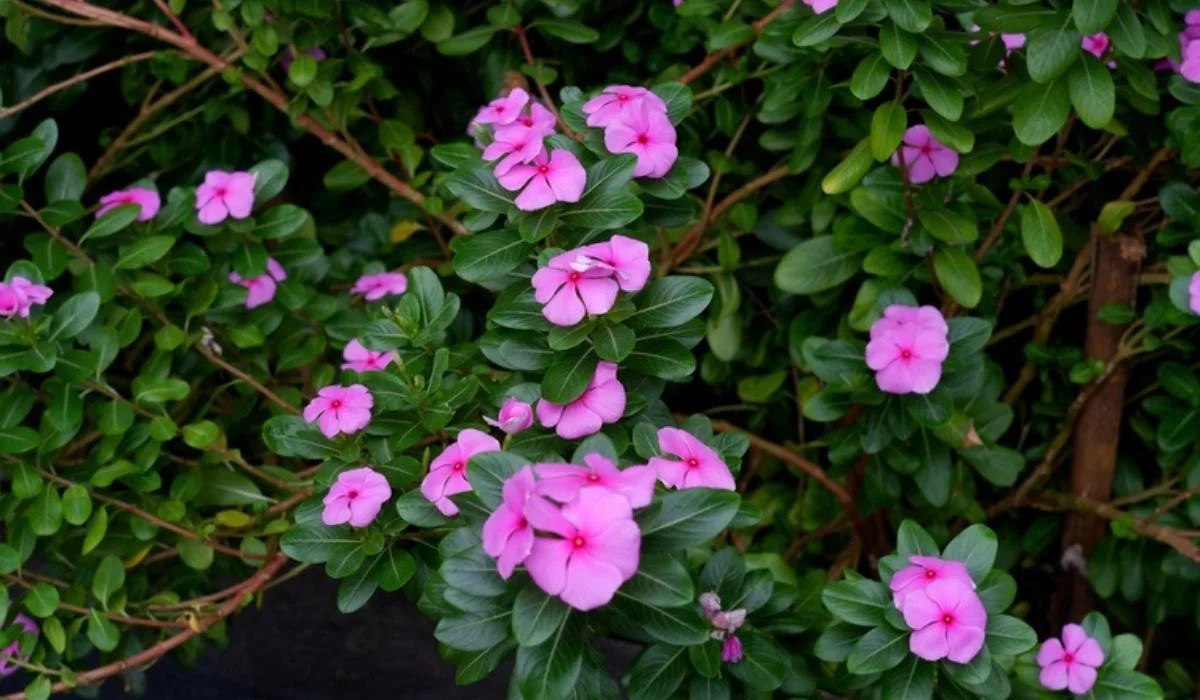
When it comes to beautiful and versatile flowers, periwinkles definitely steal the show. These small, delicate flowers are not only visually appealing but also hold some intriguing facts that make them all the more fascinating. Whether you are a plant enthusiast or simply appreciate the beauty of nature, learning more about these enchanting blooms will surely pique your interest.
In this article, we will explore 12 intriguing facts about periwinkles that will enhance your knowledge about these remarkable flowers. From their rich history to their medicinal properties, there is much more to periwinkles than meets the eye. So, buckle up and get ready to dive into the world of periwinkles as we unveil some intriguing and little-known facts about these delightful plants.
Key Takeaways:
- Periwinkle is a beautiful and low-maintenance plant with colorful blooms, making it perfect for gardens. It also has medicinal properties and cultural significance, adding to its allure.
- Periwinkle’s versatility extends from erosion control to attracting pollinators and being used in traditional dyeing. Its enchanting blooms and rich cultural history make it a captivating plant for nature enthusiasts.
Periwinkle is a versatile flowering plant.
Periwinkle, scientifically known as Vinca, is a genus of flowering plants that belongs to the Apocynaceae family. It is native to Europe but can now be found growing in various parts of the world. With its vibrant blooms and glossy green leaves, periwinkle is a popular choice for gardeners and landscapers.
Periwinkle comes in a variety of colors.
One of the fascinating aspects of periwinkle is its wide range of colors. From shades of blue, purple, and pink to white, periwinkle flowers can brighten up any garden or floral arrangement. Its colorful blooms make it a favorite amongst garden enthusiasts.
Periwinkle has medicinal properties.
Periwinkle has been used in traditional medicine for centuries. It contains alkaloids like vincamine and vinblastine that have been found to have potential health benefits. Vincamine is known for its cognitive enhancing properties, while vinblastine is used in chemotherapy treatments.
Periwinkle is a symbol of friendship.
In many cultures, periwinkle is considered a symbol of friendship. It is often exchanged between friends as a token of affection and loyalty. Its delicate and elegant flowers make it the perfect gift for someone special.
Periwinkle is a low-maintenance plant.
If you are new to gardening or have limited time for maintenance, periwinkle is an ideal choice. It is a hardy plant that can thrive in various soil conditions and requires minimal care. Once established, periwinkle can tolerate drought and bloom profusely.
Periwinkle is attractive to pollinators.
Periwinkle flowers have a sweet fragrance that attracts butterflies, bees, and other pollinating insects. By planting periwinkle, you can create a pollinator-friendly garden and contribute to the conservation of these important species.
Periwinkle is used for erosion control.
The trailing habit of periwinkle makes it effective for erosion control on slopes and banks. Its dense foliage and extensive root system help stabilize the soil and prevent erosion, making it a valuable plant for landscaping purposes.
Periwinkle has cultural significance.
In some cultures, periwinkle holds cultural and religious significance. For example, in Hindu mythology, the periwinkle flower is associated with Goddess Saraswati, the deity of knowledge and music.
Periwinkle is used in traditional dyeing.
The petals of periwinkle flowers can be used to create natural dyes. The colors range from shades of purple to pink, and they are often used to dye fabrics and yarns in traditional textile industries.
Periwinkle has a long blooming season.
One of the enchanting qualities of periwinkle is its long blooming season. It can produce flowers from spring until fall, adding color and beauty to your garden throughout the warmer months.
Periwinkle is believed to have magical properties.
In folklore and mythology, periwinkle is associated with magical properties. It is believed to bring good luck, protection, and ward off evil spirits. Some even claim that wearing periwinkle flowers can enhance psychic abilities.
Periwinkle is used in landscaping.
Periwinkle is a popular choice for landscaping projects due to its versatility and adaptability. It can be used as ground cover, in rock gardens, border plantings, and as a trailing plant in containers. Its ability to spread and fill spaces makes it an excellent choice for creating lush and colorful landscapes.
The Beauty and Versatility of Periwinkle
Periwinkle, also known as Vinca, is a flowering plant that has captured the hearts of gardeners and nature enthusiasts alike. The 12 intriguing facts about periwinkle showcase its beauty, versatility, and cultural significance.
These stunning flowers come in a variety of colors, including vibrant shades of blue, purple, and pink. Their delicate blooms and glossy green leaves create a visually appealing display in gardens and floral arrangements. Moreover, periwinkle is incredibly low-maintenance, making it an ideal choice for both experienced gardeners and beginners.
Beyond its aesthetic appeal, periwinkle possesses medicinal properties as well. Some of its compounds, such as vincamine and vinblastine, hold potential health benefits. Vincamine has been found to enhance cognitive function, while vinblastine is utilized in chemotherapy treatments.
Throughout history, periwinkle has held cultural significance in various societies. It has been associated with friendship, making it a symbolic gift exchanged between friends. In Hindu mythology, periwinkle is linked to Goddess Saraswati, the deity of knowledge and music. It is believed that wearing periwinkle flowers can enhance psychic abilities and protect against evil spirits in some folklore and mythology.
Aside from its cultural and medicinal uses, periwinkle has practical applications as well. Its trailing habit and dense foliage make it an effective plant for erosion control. The extensive root system stabilizes the soil, preventing erosion on slopes and banks. Additionally, periwinkle is frequently utilized in landscaping projects due to its versatility. It can be used as ground cover, in rock gardens, or as a trailing plant in containers, enhancing the overall aesthetic appeal of outdoor spaces.
The enchanting blooms of periwinkle attract pollinators such as butterflies and bees, contributing to the conservation of these vital species. Moreover, periwinkle flowers have been utilized for traditional dyeing, creating vibrant shades of purple and pink for fabrics and yarns.
In conclusion, the 12 intriguing facts about periwinkle highlight its diverse qualities and allure. Whether you’re drawn to its vibrant flowers, its low-maintenance nature, or its rich cultural significance, periwinkle is a fascinating plant that continues to captivate and enchant us.
Conclusion
In conclusion, periwinkles are fascinating plants with a rich history and an array of intriguing facts. From their medicinal properties to their beautiful blooms, periwinkles have captivated the attention of botanists, gardeners, and nature enthusiasts alike. Whether you’re looking to add a pop of color to your garden or exploring the potential health benefits, periwinkles are certainly a plant worth discovering. So next time you come across these delicate flowers, take a moment to appreciate their beauty and remember the incredible stories they hold.
FAQs
1. What are the different types of periwinkle?
There are two main types of periwinkle: the common periwinkle (Vinca minor) and the bigleaf periwinkle (Vinca major).
2. Are periwinkles easy to grow?
Yes, periwinkles are relatively easy to grow. They thrive in a variety of soil conditions and require minimal maintenance.
3. Can periwinkles be grown indoors?
Yes, periwinkles can be grown indoors as long as they receive sufficient sunlight and are provided with the right growing conditions.
4. Are periwinkles poisonous?
No, periwinkles are not poisonous. However, it is always best to keep them out of reach of children and pets.
5. What are the medicinal uses of periwinkle?
Periwinkle has been used in traditional medicine to treat various ailments such as diabetes, high blood pressure, and even cancer. However, it is important to consult a healthcare professional before using periwinkle for medicinal purposes.
If you enjoyed learning about periwinkle, why not explore other fascinating plants? Discover the astonishing beauty of helleborus, a stunning garden plant that thrives in shade. Uncover the enigmatic properties of thyme, a versatile medicinal plant with a rich history. Finally, dive into the world of ajuga, a hardy ground cover that adds intrigue to any landscape.
Was this page helpful?
Our commitment to delivering trustworthy and engaging content is at the heart of what we do. Each fact on our site is contributed by real users like you, bringing a wealth of diverse insights and information. To ensure the highest standards of accuracy and reliability, our dedicated editors meticulously review each submission. This process guarantees that the facts we share are not only fascinating but also credible. Trust in our commitment to quality and authenticity as you explore and learn with us.


